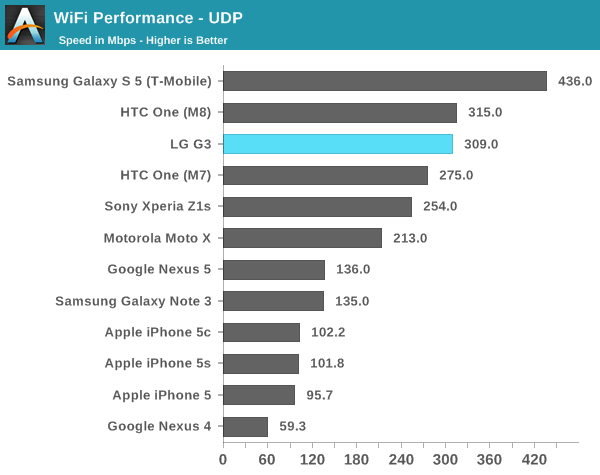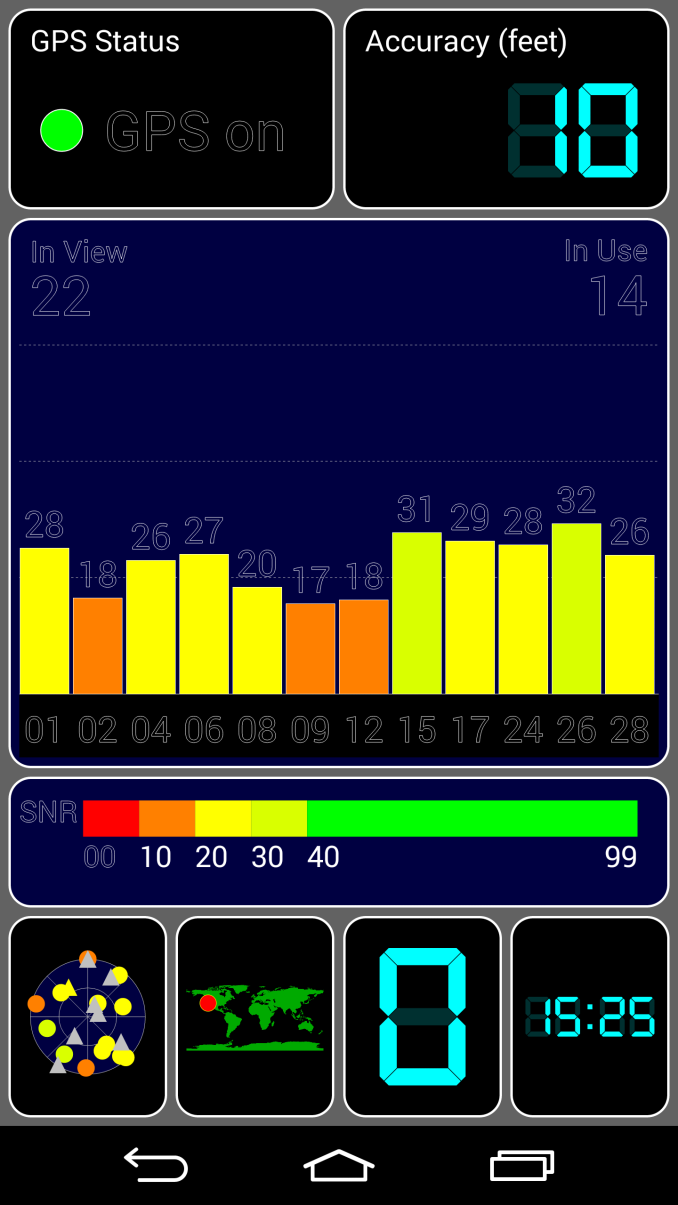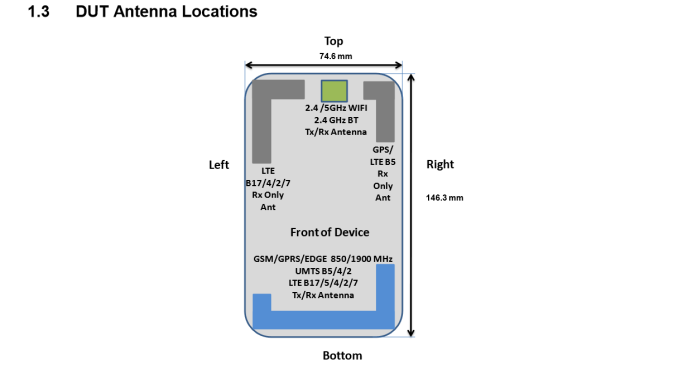The LG G3 Review
by Joshua Ho & Anand Lal Shimpi on July 4, 2014 5:00 AM EST- Posted in
- Smartphones
- LG
- Mobile
- Laptops
- G3
WiFi
These days, most OEMs seem to be using either Qualcomm's WCN3680 or Broadcom's BCM4354, depending upon whether the OEM wants to use a 1x1 or 2x2 antenna configuration. Surprisingly, LG bucks this trend by using Broadcom's BCM4339, a combo WiFi/BT/FM chip that we first saw in smartphones such as the Note 3 and Nexus 5. The WiFi antenna in this case seems to be along the top edge of the phone. It seems that LG has done some work to improve performance on this platform, as we see near parity with the One (M8)'s WCN3680 setup when the Nexus 5 and Note 3 were noticeably worse in performance. I suspect that LG selected this part with the specific goal of maintaining commonality and driving down cost by increasing volume. In this case, there doesn't seem to be any real disadvantage, especially because going to 2x2 hasn't quite doubled transfer speeds in practice.

GNSS
While GNSS quality was once a significant issue in the age of the Galaxy S and HTC Desire, today things couldn't be further from the truth. Almost every smartphone uses the MDM9x25 IP block in one way or another, and this means that GPSOne Gen8B is included as well for GLONASS, GPS, and Beidou support. Overall, accuracy is strong and the time to first lock is extremely fast, even without assistance data. On a cloudy day in San Jose it took around 30 seconds to do a true cold lock without assistance data.
Cellular
For the most part, there's not much new here as this cellular architecture is shared by the One (M8) and Galaxy S5. Namely, the G3 has an MDM9x25 modem, a WTR1625L and WFR1620 transceiver for carrier aggregation, and an Avago power amplifier for the antenna. I didn't notice much in the way of issues with cellular reception or anything else on the G3, although it seems that the SKT variant we were sampled doesn't read AT&T USSD codes correctly. This should be resolved by buying the correct regional variant. The photo below shows general antenna placement for the variants that I've seen, but banding will differ.
Rear Speaker
Unfortunately, I don't yet have the necessary equipment to test speakerphone volume on devices, but subjectively LG has put a solid speaker into the G3. It's still rear-facing, but both volume and quality are good enough to be comparable to the M8. Curiously, rather than an NXP speaker protection IC, LG has gone for a Cirrus Logic solution that identifies itself as the CS35L32. Based upon a quick search on the internet, this appears to be an obsolete part, with not much else in the way of available information.
Misc
While I'm unable to test the wireless charging functionality, I've found that the LG G3 uses IDT's IDTP9025A Qi receiver with support of the Qi 1.1 spec, which improves sensitivity to foreign objects that could heat up the phone. The NXP PN547 NFC chip in the G3 also supports host card emulation, so Google Wallet tap and pay transactions should work without issue. There's also a Maxim MAX17048 fuel gauge in the phone, which means that no battery calibration routine is required, with automatic self-correction of errors in battery charge level. It's also a bit interesting to see that a TI BQ24296 charger chip is used instead of a Qualcomm solution, which means that the Quick Charge protocol isn't supported. It seems that signalling is done via BC 1.2. The G3 uses Qualcomm's Fluence noise cancellation technology for phone calls.












174 Comments
View All Comments
SleepyFE - Friday, July 4, 2014 - link
An Android phone works without SIM, so why does pulling it out reset it? Does the flight mode reset it as well?And you can't tell me that's a non-excuse. If you pay 200€ for a phone and you can't use it after a freeze. I would be very pissed off. A power off switch under the cover that physically cuts power would be the best way to go, but no review ever mentioned that, as far as i know.
ZeDestructor - Friday, July 4, 2014 - link
Some form of security perhaps? I just noticed it in the manual where it states that removing the SIM-card from a powered phone will cause it to reboot.If I pay any amount for a phone and it freezes unreacoverably, I would be pissed too, but like I said, there is a key you can press to power off, or you can implement some form of key combo or long-press. Be pissed at the implementation and manufacturer, not the concept.
Besides, just about the only time I've had an android phone lock up was when I overclocked or ran very early custom ROMs, something I don't do since I got a Sony phone, their ROM being so lighweight and bloat-free (admittedly after uninstalling/disabling bundled stuff like facebook) in comparison to the usual Touchwiz/Sense4 bloat
SleepyFE - Friday, July 4, 2014 - link
At the time i did not know about the factory reset button combo, but removing the battery was so easy i didn't give it a second thought (until now). Factory reset means that you have to install all the apps and change the settings. Your google account has that stored but it still takes time to download everything.ZeDestructor - Friday, July 4, 2014 - link
It doesn't do a factory reset, just a hard reboot, similar to what happens when you press the reset button on desktop computers. If it has one...What I would like on the other hand would be that the back cover would be bolted to the frame, rather than glued... means I could swap the battery when it wears out, like current lightweight laptops/ultrabooks have.
SleepyFE - Friday, July 4, 2014 - link
It did a factory reset for me on LG L5. Or maybe i pressed the wrong combo (volume up + power off). Who know anymore. I didn't have to do it since.The possible battery swap sounds perfect. Kind of like a removable battery, but only the cover holds it in place, so the phone can stay thin. Is that what you meant?
ZeDestructor - Saturday, July 5, 2014 - link
Yup. I don't mind pulling wires or carefully avoiding PCBs (And I bloody well should be, given I'm a Computer Engineering student!), and I understand why the batteries are sealed (less redundant casing), but I would like the replaceability to remain. Thus some screws holding things together looks like a good compromise to me: things can stay thin for marketing, I get my repairability, everyone is happy.ZeDestructor - Friday, July 4, 2014 - link
How do you measure up the Sony Xperia Z line? They all have strict "bands" in the phone body for different elements between the screen and the back panel: top is just enough room for a double-sided PCB containing almost all the electronics, the very bottom contains a speaker, microphone, vibrator, camera button and some antennas which leaves the middle as a large battery block, which as of right now is the biggest battery in a non-phablet phone.phoenix_rizzen - Friday, July 11, 2014 - link
Xperia Z: 2330 mAhXperia Z1: 3000 mAh
Xperia Z2: 3200 mAh
G2: 3000 mAh
G3: 3000 mAh
So, out of the complete Z line up, only 1 has a larger battery, and each of the phones is physically larger (taller and wider) with smaller screens (diagonal) than either the G2 or G3.
rxzlmn - Tuesday, July 15, 2014 - link
Well, the current one (who would care about past models?) does have the bigger battery. And the screen has the same diagonal as the G2.H20_mike - Saturday, July 5, 2014 - link
The slight increase in volumetric efficiency doesn't make up for the loss of capacity over time that all LIPO batteries suffer with enough charge cycles. As a heavy user having the option to replace the battery with a new one is a huge benefit. Also nice if buying a used and not knowing the state of the battery.